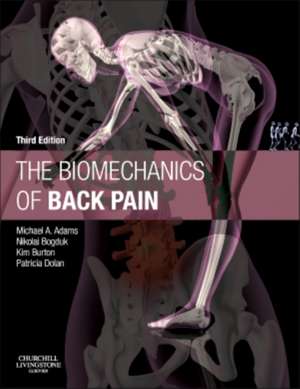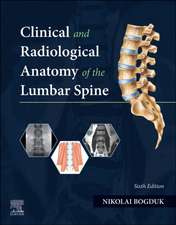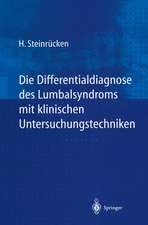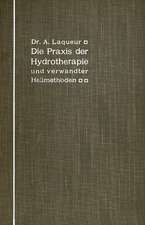The Biomechanics of Back Pain
Autor Michael A. Adams, Nikolai Bogduk, Kim Burton, Patricia Dolanen Limba Engleză Hardback – 27 sep 2012
Now published for the first time in full colour, the volume presents a unique synthesis of the latest research findings and explains its recent changes in emphasis - from trying to understand and reverse age-related spinal degeneration to addressing the soft tissue causes of pain.
New chapters are devoted to Sensorimotor Control, and Cervical Spine Anatomy and Biomechanics, while a bonus website contains useful PowerPoint presentations, which include seminars entitled Back Pain and Forces on the Spine as well as an overview of the Psychosocial Flags Framework.
Clinically orientated and highly practical throughout, The Biomechanics of Back Pain has become the standard platform by which readers keep abreast of research and developments in the field and is essential for all clinicians involved in the care and treatment of patients with back pain, as well as for those studying its causes and methods of prevention.
"The final remarks of the authors include-'There is good evidence that the psychosocial characteristics of many patients with chronic back pain are not the underlying cause of the problem; rather they are a response to vague diagnosis,ineffective treatment and a "compensation culture.' As more than half the content of this book is of direct relevance to OH professionals, I have no hesitation in recommending that it has a place on our bookshelves." Reviewed by: John Challenor, Oxford Journals Clippings, Occupational Medicine, vol 64, no 7, Date: Oct 2014
Preț: 339.76 lei
Preț vechi: 421.81 lei
-19% Nou
65.03€ • 70.66$ • 54.66£
Carte tipărită la comandă
Livrare economică 14-28 aprilie
Specificații
ISBN-10: 0702043133
Pagini: 336
Ilustrații: Approx. 230 illustrations (230 in full color)
Dimensiuni: 189 x 246 x 23 mm
Greutate: 0.95 kg
Ediția:Revised
Editura: Elsevier
Locul publicării:Edinburgh, Scotland, United Kingdom
Public țintă
All clinicians, researchers and post-graduate students concerned with the management of back pain - orthopaedic surgeons and rheumatologists, physical therapists, chiropractors, osteopaths, manual therapists, and physiotherapistsCuprins
1. Introduction
2. The vertebral column and adjacent structures
3. Muscles and fascia of the lumbar spine
4. Nerves and blood supply to the lumbar spine
5. Back pain
6. Epidemiology of back trouble
7. Biology of spinal tissues
8. Growth and ageing of the spine
9. Forces acting on the thoracolumbar spine
10. Mechanical function of the thoracolumbar spine
11. Mechanical damage to the thoracolumbar spine
12. Cervical spine biomechanics
13. Posture, creep and "functional pathology"
14. Sensorimotor control
15. Spinal degeneration
16. Preventing back pain
17. Conservative management of back pain
18. Biomechanics rationale for spinal surgery
19. Surgery for disc prolapse, spinal stenosis and back pain
20. Medico-legal considerations
21. Summary and Conclusions
Descriere
Authored by experts of international renown, the new edition of The Biomechanics of Back Pain forms a bridge between the latest research and the effective clinical management of patients with back problems.
Now published for the first time in full colour, the volume presents a unique synthesis of the latest research findings and explains its recent changes in emphasis - from trying to understand and reverse age-related spinal degeneration to addressing the soft tissue causes of pain.
New chapters are devoted to Sensorimotor Control, and Cervical Spine Anatomy and Biomechanics, while a bonus website contains useful PowerPoint presentations, which include seminars entitled Back Pain and Forces on the Spine as well as an overview of the Psychosocial Flags Framework.
Clinically orientated and highly practical throughout, The Biomechanics of Back Pain has become the standard platform by which readers keep abreast of research and developments in the field and is essential for all clinicians involved in the care and treatment of patients with back pain, as well as for those studying its causes and methods of prevention.
"The final remarks of the authors include-'There is good evidence that the psychosocial characteristics of many patients with chronic back pain are not the underlying cause of the problem; rather they are a response to vague diagnosis,ineffective treatment and a "compensation culture.' As more than half the content of this book is of direct relevance to OH professionals, I have no hesitation in recommending that it has a place on our bookshelves." Reviewed by: John Challenor, Oxford Journals Clippings, Occupational Medicine, vol 64, no 7, Date: Oct 2014


















